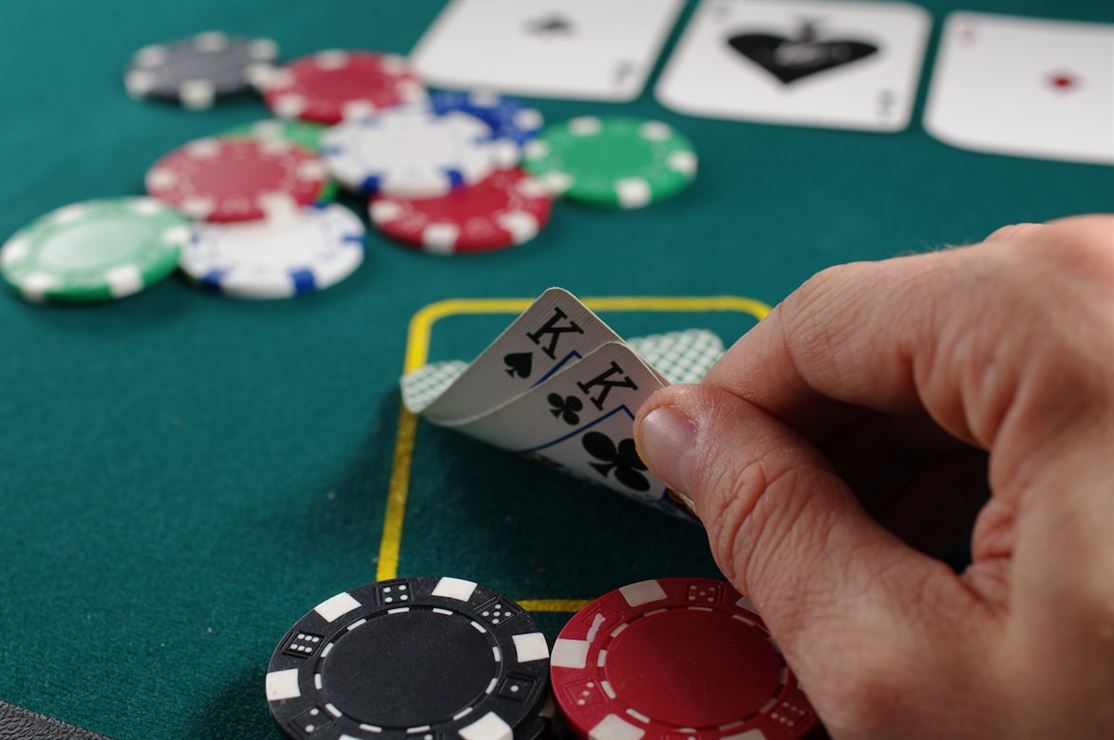Poker is a game that combines skill, strategy, and a bit of luck. While many players rely on their intuition or gut feeling to make decisions at the poker table, there is another aspect of the game that can greatly improve your chances of success: understanding poker mathematics. By mastering odds and probabilities, you can make more informed decisions and increase your overall profitability.
Understanding Poker Mathematics: Calculating Odds and Probabilities
One of the key concepts in poker mathematics is calculating odds. Odds are simply a way of expressing the likelihood of an event occurring. In poker, this typically refers to the likelihood of completing a certain hand. For example, if you have two hearts in your hand and there are two more hearts on the flop, you have approximately a 35% chance of hitting a flush by the river. Understanding these odds allows you to assess the value of continuing with your hand and making appropriate bets.
To calculate odds in poker, you need to know the number of outs you have. Outs are the cards that will improve your hand. For example, if you have four cards to a flush and there are nine hearts remaining in the deck, you have nine outs. To calculate the odds of hitting your flush on the next card, simply divide the number of outs by the number of unseen cards. In this case, it would be 9/47, or approximately 19%. This means that you have about a 1 in 5 chance of hitting your flush.
Probabilities are closely related to odds and refer to the likelihood of an event occurring over the long run. While odds are specific to a particular situation or hand, probabilities give us a broader perspective. For example, the probability of being dealt pocket aces is roughly 0.45%, or 1 in 220 hands. Knowing these probabilities can help you understand the rarity of certain hands and make better decisions based on the strength of your starting cards.
Understanding poker mathematics goes beyond just calculating odds and probabilities. It also involves understanding concepts such as pot odds and expected value (EV). Pot odds refer to the ratio of the current size of the pot compared to the cost of a contemplated call. By comparing the pot odds to the odds of completing your hand, you can determine whether it is profitable to continue in a hand or fold.
Expected value is another important concept in poker mathematics. It refers to the average amount of money you expect to win or lose on a particular play over the long run. By calculating the expected value of different actions, you can make more informed decisions that maximize your profitability. For example, if you have a 30% chance of winning a $100 pot, your expected value would be $30. If the cost of a bet or call is less than $30, it would be a profitable play in the long run.
In conclusion, mastering odds and probabilities is an essential skill for any serious poker player. By understanding these concepts, you can make more informed decisions at the poker table and increase your overall profitability. Calculating odds and probabilities allows you to assess the value of continuing with your hand, understand the rarity of certain hands, and make better decisions based on pot odds and expected value. So take the time to study and practice poker mathematics, and watch your game improve.
The Role of Probability in Making Informed Poker Decisions
Poker is a game of skill and strategy, but it is also a game of numbers. Understanding the role of probability in making informed poker decisions can greatly enhance a player’s chances of success at the table.
Probability is the mathematical concept that deals with the likelihood of an event occurring. In poker, understanding probabilities allows players to make rational decisions based on the potential outcomes of their actions. By calculating the odds of certain cards being dealt or the likelihood of a specific hand winning, players can make more informed choices throughout the game.
One of the most basic concepts in poker probability is the calculation of outs. Outs are the cards that can improve a player’s hand and potentially lead to a win. For example, if a player has four cards to a flush after the flop, there are nine remaining cards of that suit in the deck. Therefore, the player has nine outs to complete their flush. Calculating outs allows players to determine the probability of improving their hand and decide whether to continue betting or fold.
Another important aspect of poker probability is understanding pot odds. Pot odds refer to the ratio between the current size of the pot and the cost of a contemplated call. By comparing the pot odds to the odds of completing a drawing hand, players can determine whether it is profitable to continue playing. If the pot odds are higher than the odds of completing the hand, it may be a favorable decision to call or raise. Conversely, if the pot odds are lower than the odds of completing the hand, folding would be the wiser choice.
In addition to outs and pot odds, players must also consider implied odds when making informed poker decisions. Implied odds take into account potential future bets that could be won if a drawing hand hits. For example, if a player has a straight draw and believes they can extract additional chips from opponents if they hit their hand, the implied odds may justify continuing to play even if the immediate pot odds are not favorable. Understanding implied odds allows players to make more nuanced decisions that consider the potential future value of a hand.
Probabilities also come into play when deciding whether to bluff or not. Bluffing is a strategy used to deceive opponents into thinking you have a stronger hand than you actually do. By understanding the probability of certain cards being in their opponents’ hands based on the community cards and previous betting patterns, players can determine if a bluff is likely to be successful. Calculating the likelihood of an opponent having a strong hand versus a weak one can help inform the decision to bluff or fold.
In conclusion, probability plays a crucial role in making informed poker decisions. Whether it’s calculating outs, considering pot and implied odds, or determining the likelihood of success in a bluff, understanding the numbers behind the game can greatly improve a player’s chances of winning. By mastering the odds and probabilities, players can make rational choices that maximize their potential for success at the poker table.
Mastering the Art of Pot Odds: Maximizing Your Winnings
Poker is a game of skill and strategy, where players must make calculated decisions based on the cards they hold and the actions of their opponents. One crucial aspect of poker that separates the amateurs from the professionals is understanding and mastering pot odds. Pot odds refer to the ratio of the current size of the pot to the cost of a contemplated call. By understanding pot odds, players can make informed decisions about whether or not to continue in a hand.
To fully grasp the concept of pot odds, it’s essential to understand probability. Probability is the likelihood of an event occurring, expressed as a decimal or percentage. In poker, probability comes into play when calculating the chances of making a particular hand. For example, if you have four cards to a flush after the flop, there are nine remaining cards of that suit in the deck. Therefore, your chances of completing the flush by the river are roughly 19%.
Once you understand probability, you can use it to calculate pot odds. Pot odds compare the potential payout of a hand with the cost of calling a bet. For instance, if there is $100 in the pot, and your opponent bets $20, the pot odds would be 5:1 ($100/$20). This means that for every dollar you invest, you stand to win five dollars.
Knowing pot odds allows players to determine whether a call is profitable in the long run. If the odds of completing a winning hand are greater than the pot odds, then it’s a mathematically sound decision to call. Conversely, if the pot odds are higher than the odds of completing a hand, folding may be the best course of action.
Maximizing your winnings in poker requires making smart decisions based on pot odds. By calculating pot odds accurately, players can identify situations where the potential reward outweighs the risk. Let’s say you have a flush draw after the flop, and your opponent makes a bet that is equal to the size of the pot. If the pot odds are greater than the odds of completing your flush, calling would be a profitable move in the long run.
Another aspect to consider when mastering pot odds is implied odds. Implied odds refer to the potential additional winnings you can expect if you complete your hand. For example, if you have a straight draw with one card to come, and you believe that if you make your hand, your opponent will pay off a large bet, then your implied odds may be higher than the current pot odds. In this situation, calling would still be a favorable decision, even if the immediate pot odds aren’t in your favor.
In conclusion, understanding and mastering pot odds is crucial for maximizing your winnings in poker. By calculating the ratio of the current pot size to the cost of a contemplated call, players can make informed decisions about whether or not to continue in a hand. Probability plays a significant role in determining pot odds, as it allows players to calculate the chances of making a particular hand. By considering both pot odds and implied odds, players can make smart decisions that lead to long-term profitability. So next time you’re at the poker table, remember to crunch the numbers and let the pot odds guide your way to success.
Analyzing Expected Value in Poker: Making Profitable Moves
In the world of poker, understanding expected value is essential for making profitable moves. Expected value, often abbreviated as EV, is a mathematical concept that measures the average outcome of a particular action over the long run. By calculating the expected value of each decision, players can determine which moves are likely to be profitable and which ones should be avoided.
To calculate the expected value, one must consider both the potential gains and losses associated with a specific move. For example, let’s say a player is faced with a decision to call or fold on the river. The pot size is $100, and the player has a 25% chance of winning the hand. If the player decides to call and wins, they would gain $100. However, if they lose, they would lose their initial bet of $50. To calculate the expected value, we multiply the potential gains by the probability of winning and subtract the potential losses multiplied by the probability of losing. In this case, the expected value of calling would be ($100 * 0.25) – ($50 * 0.75) = $12.50.
By comparing the expected values of different actions, players can make informed decisions that maximize their chances of profitability. If the expected value of calling is positive, it indicates that calling is a profitable move in the long run. Conversely, if the expected value is negative, it suggests that folding would be the more prudent choice.
However, it’s important to note that expected value alone does not guarantee success in poker. Variance, luck, and other factors can influence short-term outcomes. Nonetheless, analyzing expected value provides a solid foundation for making rational decisions and improving overall profitability.
Furthermore, understanding how expected value relates to pot odds is crucial for effective decision-making. Pot odds refer to the ratio between the current size of the pot and the cost of a contemplated call. By comparing the pot odds to the odds of winning, players can determine whether a particular call is profitable in the long run.
For instance, if the pot size is $200 and a player needs to call $50 to stay in the hand, their pot odds would be 4:1. If the player’s odds of winning are higher than 4:1, calling would be a profitable move. Conversely, if the odds of winning are lower than 4:1, folding would be the more logical choice.
By combining expected value calculations with an understanding of pot odds, players can make well-informed decisions that maximize profitability while minimizing risk. This analytical approach helps separate professional poker players from amateurs, as professionals consistently make decisions based on mathematical principles rather than relying solely on intuition or emotions.
In conclusion, analyzing expected value in poker is crucial for making profitable moves. By calculating the average outcome of each decision over the long run, players can determine which actions are likely to result in positive expected values and increase their chances of success. Additionally, considering pot odds allows players to compare the potential gains to the cost of a call, further enhancing their decision-making process. While luck and variance will always play a role in poker, mastering the art of analyzing expected value gives players a significant advantage at the table.






